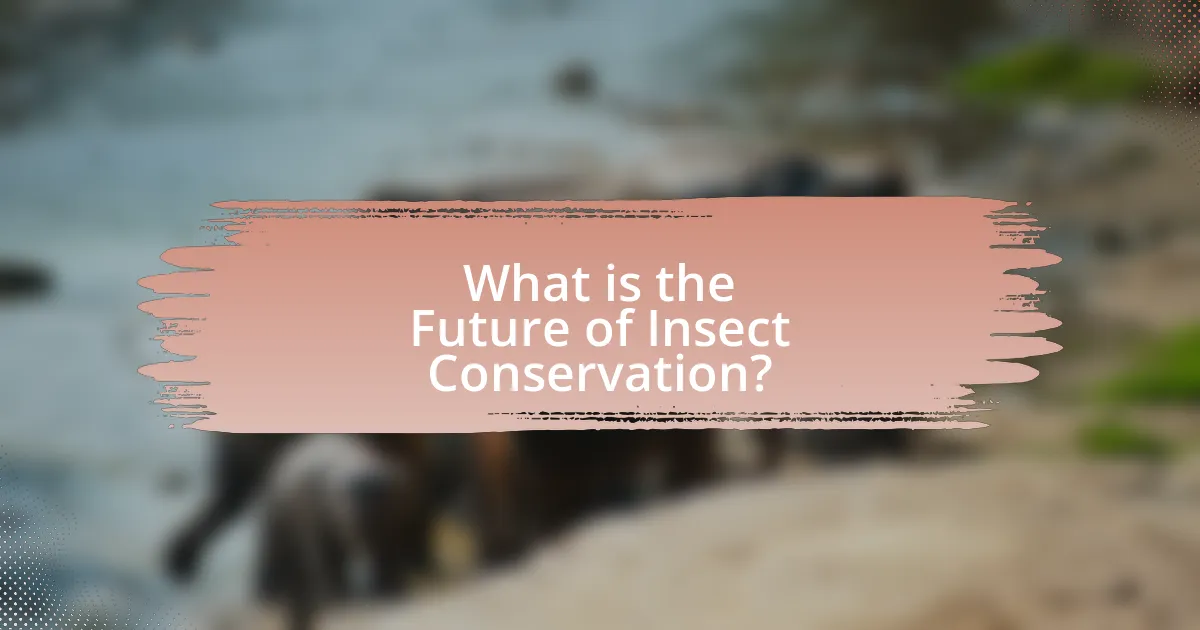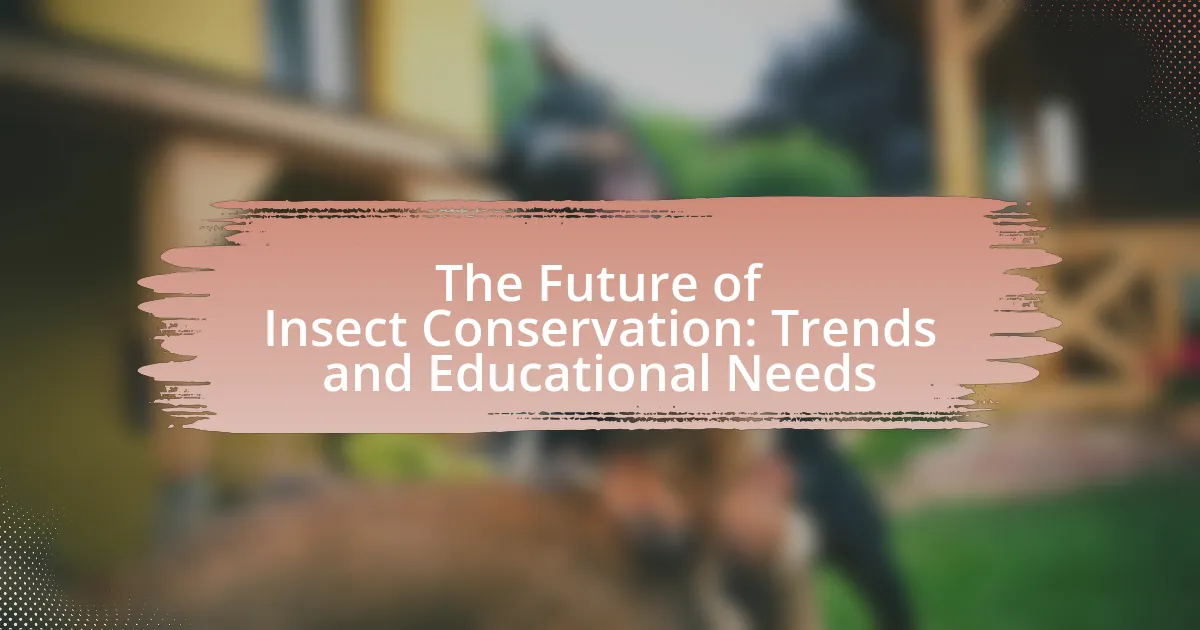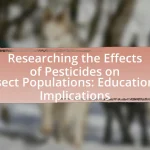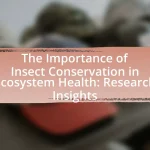The article focuses on the future of insect conservation, emphasizing the urgent need for habitat restoration, public education, and policy advocacy in response to declining insect populations. It highlights the critical ecological roles insects play, such as pollination and nutrient cycling, and discusses current trends in conservation strategies, including community engagement and technological advancements. The article also outlines the educational needs essential for effective conservation, detailing methods to raise awareness and engage the public in conservation efforts. Additionally, it addresses the challenges posed by climate change, habitat loss, and pesticide use, while proposing strategies for overcoming these obstacles through targeted education and community involvement.

What is the Future of Insect Conservation?
The future of insect conservation involves a multi-faceted approach that includes habitat restoration, public education, and policy advocacy. As insect populations decline globally, driven by habitat loss, climate change, and pesticide use, conservation efforts must prioritize creating and maintaining ecosystems that support diverse insect species. Research indicates that approximately 40% of insect species are in decline, highlighting the urgency for effective conservation strategies. Initiatives such as the establishment of protected areas, promotion of sustainable agricultural practices, and community engagement in conservation efforts are essential for reversing these trends. Furthermore, educational programs aimed at raising awareness about the ecological importance of insects can foster public support for conservation initiatives, ensuring a collaborative effort towards preserving insect biodiversity.
Why is insect conservation important for biodiversity?
Insect conservation is crucial for biodiversity because insects play essential roles in ecosystems, including pollination, nutrient cycling, and serving as food sources for other species. For instance, approximately 75% of flowering plants depend on insect pollinators, which directly supports food production and ecosystem health. Additionally, insects contribute to soil health by breaking down organic matter, thus enhancing nutrient availability for plants. The decline of insect populations, as reported in studies like the Global Assessment on Biodiversity and Ecosystem Services by the Intergovernmental Science-Policy Platform on Biodiversity and Ecosystem Services, threatens these vital ecological functions, leading to reduced biodiversity and ecosystem resilience.
What role do insects play in ecosystems?
Insects play a crucial role in ecosystems as pollinators, decomposers, and a food source for other organisms. They facilitate the pollination of approximately 75% of flowering plants, which is essential for food production and biodiversity. Additionally, insects contribute to nutrient cycling by breaking down organic matter, thus enriching the soil. For instance, beetles and ants are known to decompose dead plant and animal material, returning vital nutrients to the ecosystem. Furthermore, insects serve as a primary food source for many birds, mammals, and amphibians, supporting higher trophic levels. The decline of insect populations can disrupt these ecological functions, leading to negative consequences for ecosystem health and stability.
How do insects contribute to human well-being?
Insects contribute to human well-being primarily through their roles in pollination, decomposition, and as a food source. Pollinators, such as bees and butterflies, are essential for the reproduction of many crops and wild plants, with approximately 75% of global food crops relying on animal pollination, according to the Food and Agriculture Organization. Additionally, insects play a critical role in decomposition, breaking down organic matter and recycling nutrients back into the ecosystem, which supports soil health and plant growth. Furthermore, insects serve as a vital food source for many animals, including birds and fish, which are important for human diets and ecosystems. These contributions underscore the importance of insect conservation for maintaining ecological balance and supporting human life.
What are the current trends in insect conservation?
Current trends in insect conservation include habitat restoration, the promotion of sustainable agricultural practices, and increased public awareness campaigns. Habitat restoration focuses on creating and maintaining environments that support diverse insect populations, such as rewilding initiatives and the establishment of pollinator gardens. Sustainable agricultural practices, such as integrated pest management and organic farming, aim to reduce pesticide use and enhance biodiversity. Public awareness campaigns educate communities about the importance of insects in ecosystems, leading to greater support for conservation efforts. These trends are supported by research indicating that habitat loss and pesticide use are significant threats to insect populations, highlighting the need for targeted conservation strategies.
How are conservation strategies evolving?
Conservation strategies are evolving through the integration of technology, community involvement, and adaptive management practices. For instance, the use of remote sensing and data analytics allows for more precise monitoring of ecosystems and species, enhancing the effectiveness of conservation efforts. Additionally, community-based conservation initiatives are gaining traction, as local populations are increasingly recognized for their role in biodiversity preservation. Research indicates that involving communities leads to more sustainable outcomes, as seen in projects like the Community-Based Natural Resource Management in Namibia, which has successfully empowered local stakeholders. Furthermore, adaptive management practices are being adopted to allow for flexibility in response to changing environmental conditions, ensuring that conservation strategies remain relevant and effective.
What technological advancements are influencing insect conservation?
Technological advancements influencing insect conservation include remote sensing, genetic analysis, and artificial intelligence. Remote sensing technologies, such as satellite imagery and drones, enable researchers to monitor insect populations and habitats over large areas, providing critical data for conservation efforts. Genetic analysis techniques, including DNA barcoding, allow for precise identification of species and understanding of genetic diversity, which is essential for effective conservation strategies. Artificial intelligence is increasingly used to analyze ecological data, predict insect behavior, and optimize conservation practices, enhancing the efficiency of conservation initiatives. These advancements collectively improve the ability to protect and manage insect populations in the face of environmental challenges.

What educational needs are essential for effective insect conservation?
Effective insect conservation requires education on biodiversity, ecological roles, and conservation strategies. Understanding the importance of insects in ecosystems, such as their roles in pollination and nutrient cycling, is crucial for fostering appreciation and support for conservation efforts. Additionally, training in practical conservation techniques, such as habitat restoration and sustainable land management, equips individuals with the skills necessary to implement effective conservation practices. Research indicates that educational programs that incorporate hands-on experiences and community engagement significantly enhance public awareness and involvement in insect conservation initiatives.
How can education raise awareness about insect conservation?
Education can raise awareness about insect conservation by integrating comprehensive curricula that highlight the ecological roles of insects and the threats they face. By teaching students about the critical functions insects perform, such as pollination and decomposition, educational programs can foster a deeper understanding of their importance to ecosystems. Research indicates that experiential learning, such as field trips and hands-on activities, significantly enhances students’ engagement and retention of information regarding biodiversity and conservation efforts. For instance, a study published in the Journal of Environmental Education found that students who participated in outdoor learning experiences demonstrated a 30% increase in knowledge about local insect species and their habitats. This evidence supports the effectiveness of education in promoting awareness and encouraging proactive conservation behaviors among individuals and communities.
What are the most effective educational methods for engaging the public?
The most effective educational methods for engaging the public include interactive workshops, community-based projects, and digital storytelling. Interactive workshops allow participants to actively engage with the material, fostering a deeper understanding of insect conservation. Community-based projects, such as local habitat restoration, encourage hands-on involvement and create a sense of ownership among participants. Digital storytelling utilizes multimedia platforms to share compelling narratives about insects, making the information accessible and relatable. Research by the National Academies of Sciences, Engineering, and Medicine highlights that experiential learning significantly enhances public engagement and retention of information, demonstrating the effectiveness of these methods in promoting awareness and action in conservation efforts.
How can schools incorporate insect conservation into their curricula?
Schools can incorporate insect conservation into their curricula by integrating hands-on activities, interdisciplinary lessons, and community engagement projects focused on local insect species. For instance, science classes can include field studies where students observe and document insect populations, fostering a direct connection to biodiversity. Additionally, art and literature classes can explore themes of insects in ecosystems, promoting awareness through creative expression. Research indicates that experiential learning significantly enhances student understanding and retention of ecological concepts, as shown in studies like “The Impact of Outdoor Learning on Student Engagement” by the University of Exeter. By combining these approaches, schools can effectively educate students about the importance of insect conservation and its role in environmental health.
What resources are available for educators and conservationists?
Educators and conservationists have access to a variety of resources, including online platforms, educational materials, and community programs. Notable resources include the North American Pollinator Protection Campaign, which provides educational tools and guidelines for pollinator conservation, and the Xerces Society for Invertebrate Conservation, offering research publications and outreach programs focused on insect conservation. Additionally, the National Wildlife Federation offers curriculum resources for educators to teach about biodiversity and conservation. These organizations support the educational needs of conservationists by providing evidence-based information and practical tools for effective conservation efforts.
What role do online platforms play in insect conservation education?
Online platforms serve as crucial tools for insect conservation education by providing accessible information, fostering community engagement, and facilitating collaboration among stakeholders. These platforms, such as educational websites, social media, and online courses, enable users to learn about insect biodiversity, threats to their habitats, and conservation strategies. For instance, organizations like the Xerces Society utilize their website to disseminate research findings and conservation tips, reaching a global audience. Additionally, social media campaigns can raise awareness and mobilize public support for insect conservation initiatives, exemplified by hashtags like #SaveTheBees, which have garnered millions of interactions. Thus, online platforms significantly enhance the reach and effectiveness of insect conservation education efforts.
How can community programs support insect conservation efforts?
Community programs can support insect conservation efforts by engaging local populations in education, habitat restoration, and citizen science initiatives. These programs raise awareness about the ecological importance of insects, which are vital for pollination, nutrient cycling, and food webs. For instance, educational workshops can inform community members about the decline of insect populations and the actions they can take to mitigate this issue, such as creating pollinator gardens or reducing pesticide use. Additionally, community-led habitat restoration projects can enhance local ecosystems, providing essential resources for insects. Research indicates that citizen science initiatives, where community members collect data on local insect populations, can contribute valuable information to conservation efforts and foster a sense of stewardship among participants.

What challenges does insect conservation face in the future?
Insect conservation faces significant challenges in the future, primarily due to habitat loss, climate change, and pesticide use. Habitat loss, driven by urbanization and agricultural expansion, reduces the availability of essential environments for insects, leading to population declines. Climate change alters ecosystems and disrupts the life cycles of many insect species, making it difficult for them to adapt. Additionally, the widespread use of pesticides poses direct threats to insect populations, as these chemicals can be toxic and reduce biodiversity. According to a study published in the journal “Biological Conservation,” nearly 40% of insect species are experiencing population declines, highlighting the urgency of addressing these challenges for effective conservation efforts.
How do climate change and habitat loss impact insect populations?
Climate change and habitat loss significantly reduce insect populations by altering their environments and disrupting their life cycles. Rising temperatures can lead to mismatches in the timing of life stages, such as breeding and food availability, which can decrease reproductive success. Additionally, habitat loss due to urbanization and agriculture diminishes the resources insects rely on, such as food and shelter, leading to population declines. Research indicates that insect biomass has decreased by 75% in some areas over the past few decades, highlighting the urgent need for conservation efforts to address these impacts.
What specific insects are most at risk due to environmental changes?
Butterflies, bees, and certain beetle species are among the specific insects most at risk due to environmental changes. Climate change, habitat loss, and pesticide use significantly threaten these insects. For instance, studies indicate that many butterfly populations have declined by over 50% in the last few decades due to rising temperatures and habitat fragmentation. Similarly, bee populations are experiencing dramatic declines, with some species facing extinction as a result of changing climates and agricultural practices. Research published in the journal “Nature” highlights that nearly 40% of insect species are declining globally, emphasizing the urgent need for conservation efforts.
How can conservationists address these challenges effectively?
Conservationists can address challenges in insect conservation effectively by implementing targeted education and awareness programs. These programs can inform the public about the ecological importance of insects, as studies show that insects contribute to pollination, nutrient cycling, and pest control, which are vital for ecosystem health. Additionally, conservationists can collaborate with policymakers to develop and enforce regulations that protect insect habitats, as evidenced by successful initiatives in regions where habitat preservation has led to increased insect populations. Engaging local communities in conservation efforts through citizen science projects can also enhance data collection and foster a sense of stewardship, ultimately leading to more effective conservation outcomes.
What strategies can be implemented to overcome educational barriers?
To overcome educational barriers in the context of insect conservation, strategies such as integrating hands-on learning experiences, utilizing technology for remote education, and fostering community partnerships can be implemented. Hands-on learning experiences, like field trips and interactive workshops, enhance engagement and understanding of insect conservation topics. Technology, including online courses and virtual reality, expands access to education, particularly for remote or underserved populations. Community partnerships with local organizations can provide resources and support, creating a network that promotes awareness and education about insect conservation. These strategies are supported by research indicating that experiential learning and community involvement significantly improve educational outcomes in environmental science.
How can partnerships between organizations enhance conservation education?
Partnerships between organizations can enhance conservation education by leveraging diverse expertise and resources to create comprehensive educational programs. Collaborative efforts allow organizations to combine their strengths, such as scientific research, community outreach, and funding, resulting in more effective and engaging educational initiatives. For instance, a partnership between a university and a non-profit organization can facilitate the development of hands-on workshops and field studies that provide practical experiences for participants. Research indicates that collaborative educational programs can increase participant engagement and retention of information, as seen in studies conducted by the National Science Foundation, which highlight the effectiveness of interdisciplinary approaches in education.
What best practices can be adopted for community engagement in insect conservation?
Best practices for community engagement in insect conservation include fostering local partnerships, implementing educational programs, and promoting citizen science initiatives. Local partnerships with schools, NGOs, and community groups enhance resource sharing and increase outreach effectiveness. Educational programs that focus on the ecological importance of insects can raise awareness and encourage positive attitudes towards conservation. Citizen science initiatives, where community members participate in data collection and monitoring, empower individuals and provide valuable data for conservation efforts. Research indicates that community involvement significantly improves conservation outcomes, as seen in projects like the Butterfly Conservation’s “Big Butterfly Count,” which engages thousands of volunteers in monitoring butterfly populations across the UK.


